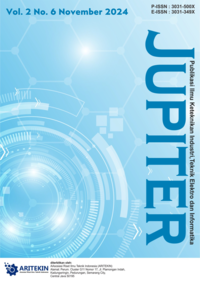Analisa Simulasi Aliran Gas Buang pada Instalasi Exhaust Bengkel Las menggunakan Metode Computationl Fluid Dynamics-CFD dengan Flow Simulation-Solidwork
DOI:
https://doi.org/10.61132/jupiter.v2i6.748Keywords:
Computational Fluid Dynamics, Flow Simulation, Welding Exhaust Gas, Solidwork ApplicationsAbstract
Smoke hazards can result in poisoning of harmful gases produced by the welding process. So it is expected that in order to maintain air cleanliness in the welding workshop by installing an exhaust gas channel from welding, the purpose of this research is to analyse the flow of exhaust gas through simulation of fluid flow velocity (welding smoke) in the design of exhaust gas installation in the welding workshop using CFD or Computational Fluid Dynamics method. CFD simulation can predict in detail the movement of wind (moving fluid) in the welding fume exhaust duct. CFD simulation is carried out through three stages, namely pre-processing, solving, and post-processing. This CFD uses the Solidworks (Flow Simulation) application programme. It was found that the installation of a welding fume exhaust duct with an output capacity of 39 m³ per minute showed a significant increase in airflow velocity. The first simulation results at the exhaust fan (welding booth) showed a maximum velocity value of 13.14 m/s and an average velocity of 10.55 m/s, the Reynold's number was 84567.11. In the second simulation, with the axial fan (Fan stationary) at 2600 RPM and pipe diameter 127 mm, better results were obtained, namely minimum velocity of 12.88 m/s, average velocity 13.94 m/s, maximum velocity 14.53 m/s and Reynold's number 111512.74. So the simulation results show an improvement in the performance of the ventilation system, where the airflow velocity is quite good, which ensures the efficiency of the ventilation system.
References
DS. (2012). SolidWorks Flow Simulation.
Aldio. (2022). Pengembangan lemari asam dengan variasi kecepatan putaran exhaust fan.
Bhatia, A. (2021). Duct components & materials. Retrieved from How to size and design duct. [Online document]. https://www.scribd.com/document/548363640/000-Modul-HVAC-How-To-Size-And-Design-Ducts-R1-En-Id
Eko Riswan, W. S. (2013). Rancang bangun mesin pendingin pada mesin las titik menggunakan metode closed flow. Jurnal Teknik Mesin, 2(1). ISSN 2252-4444.
Febri Dwi Nugroho. (2020). Analisis distribusi kecepatan, tekanan dan temperatur pada perancangan saluran gas buang mobil desa dengan menggunakan software SolidWorks [Undergraduate thesis, Universitas Negeri Semarang]. https://lib.unnes.ac.id/41064/
Galliera, J. (2015, January 8). Goals in SolidWorks Flow Simulation. The SolidWorks Blog. https://blogs.solidworks.com/solidworksblog/2015/01/goals-in-solidworks-flow-simulation.html
Jalaluddin, J., Akmal, S., Za, N., & Ishak, I. (2019). Analisa profil aliran fluida cair dan pressure drop pada pipa L menggunakan metode simulasi computational fluid dynamics (CFD). Jurnal Teknologi Kimia Unimal, 8(1), 97. https://doi.org/10.29103/jtku.v8i1.3396
Rueda, J. (2019). Tutorial SolidWorks Flow Simulation 201920200602 7350 1i9rhz. https://www.academia.edu/43237133/Tutorial_SolidWorks_Flow_Simulation_201920200602_7350_1i9rhz
Simulasi computational fluid dynamics (CFD) pada boiler – Aeroengineering.co.id. (2021, September 26). https://www.aeroengineering.co.id/2021/01/simulasi-computational-fluid-dynamics-cfd-pada-boiler/
Susanto, R. E. W. S., Dewi, Y. P., Setiawan, D., Cahyono, H., & Bahtiar, A. D. M. (2023). Design of vacuum machine for separating metal scrap waste with oil cutting using Autodesk Inventor: Perancangan desain mesin vakum pemisah limbah geram dengan oil cutting menggunakan Autodesk Inventor. Jurnal Teknik Mesin, 2(1), 181–190.
Widiarta, I. P., Suarda, M., Sucipta, M., & Sukadana, I. G. K. (2022). Simulasi CFD pertukaran udara di ruang tindakan klinik kesehatan. Jurnal Mettek, 8(2), 83. https://doi.org/10.24843/Mettek.2022.V08.I02.P03
Yanuar, D. (2014). Koefisien gesek pada rangkaian pipa dengan variasi diameter dan kekasaran pipa.
Downloads
Published
How to Cite
Issue
Section
License
Copyright (c) 2024 Jupiter: Publikasi Ilmu Keteknikan Industri, Teknik Elektro dan Informatika

This work is licensed under a Creative Commons Attribution-ShareAlike 4.0 International License.






